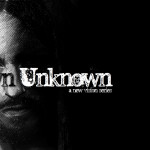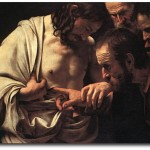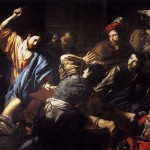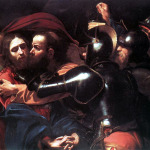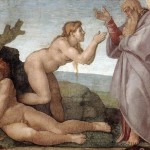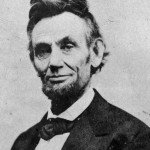Over the years I’ve encountered many Christians concerned with symbolism in the Gospel of John. They’re particularly troubled with the notion that John intended objects and images to convey a coded meaning. They might be bothered for instance that
- the “water jar” in John 4:28-29 points to the woman’s abandonment of tradition
- the “night” in John 3:1 and 13:30 refers to more than just time of day.
- the parenthetical naming of the servant in John 18:10 is included because it means kingdom.
- Or that the water which flows from Jesus’ side in John 19:34 represents the Holy Spirit.
And they, of course, have reasons for their concern. Two come to mind.
(1) Symbols seem the product of an overly imaginative author tampering with historical fact. Like a story with too many coincidences, symbols rub at our confidence in an eyewitness report. We expect witnesses to give fresh, trivial details of what they’ve seen and heard. But the presence of meaningful objects point to a premeditated creativity. Where might history end and the authors imagination begin?
(2) Symbolic interpretations appear to bypass the plain meaning of the text. Good interpretation must be grounded in rules which cause readers of varying backgrounds to arrive at similar conclusions. Since the “discovery” of symbols has all too often varied from one interpreter to the next, they appear to arise from an “interpreter’s” whim and not the text itself.
Bottom line: symbols hijack history and or the author’s true intent.
I think we should heed these cautions. The way a symbolic reading is presented can indeed lead some to question the gospel’s veracity. Likewise without proper criteria the claim of symbolism is open to abuse. But while we should heed these cautions it doesn’t mean we must discount John’s or the Bible’s use of symbolism. Symbols are not antithetical to history nor is the discovery of deeper meaning damned to be divorced from proper interpretive criteria. Symbols can and often are faithful to the facts.

Symbolism in History
History is full of legitimate symbols. For example, we know Abraham Lincoln was assassinated on Good Friday 1865 just five days after Palm Sunday’s official end to the Civil War. Lincoln’s final week thus corresponds significantly to Jesus’ final week. Jesus entered triumphantly into Jerusalem on Palm Sunday and on that first Good Friday he’s executed on the cross. But the correspondences do not end there. Like Jesus’s life and death, which brought spiritual freedom to humanity, Lincoln’s leadership and untimely death resulted in a “new birth of freedom” for the slaves. That authors have seen in these remarkable similarities Lincoln as a type or symbol of Christ by no means undermines their historic credibility.
Craig Koester states,
“We can discern symbolic significance in images, events, or persons without undercutting their claims to historicity, and we can recognize that certain images, events, and people are historical without diminishing their symbolic value.”
According to Xavier Leon-Dufour, Symbolism
“should be understood as putting together the surface and deeper realities rather than as evacuating the surface of the text simply to reach the deeper reality.”
Even St. Augustine saw no tension between the historical facts of John’s Gospel and the deep creativity involved in producing it. He says John,
‘is like one who has drunk in the secret of His divinity more richly and somehow more familiarly than others, as if he drew it from the very bosom of his Lord on which it was his wont to recline when He sat at meat’
The presence of symbolism in John does not mean he was an overly imaginative author. It means he reflected deeply on the significance of the events. John can faithfully record history while highlighting its profound connections and meaning.
Interpreting Symbols
Literature, both ancient and modern, is full of real and yet implicit symbols. We know that authors use symbols. But we also know not everything that is claimed as symbol is truly symbolic. So how do interpreters know which is which?
In How to Detect a Symbol, I described two ways of knowing. First, by an initiation into the author and audiences shared knowledge and experience. Like an inside joke, the author winks and the reader smiles while the uninitiated might simply be told, “just had to be there.” And secondly by the author defining the meaning of symbol within the text itself. If an author feels his audience may not readily understand his meaning, he or she will supply a definition for their audience.
In principle, people recognize the accuracy of these two criteria. It’s the extent to which they’re used which bothers some. Most, for instance, are not troubled by an author giving a word or an object an alternative meaning if and when they do so directly (i.e. x = 2). It’s troubling, however, when it’s too subtle, when we can’t connect the dots. Without a carefully considered argument, the claim of symbolism can appear as perplexing as a magician pulling a rabbit out of a hat. But such tricks aren’t real magic, rather they’re a carefully crafted illusion arising from a systematic process. It appears bewildering only because we don’t know how it works.
It takes more than an interpreter declaring, “this means X” for an object to be a symbol. To a person bypassing a careful engagement with the text we would rightly respond, “that’s just your interpretation.” A true interpretation is a matter of carefully laying out the narrative evidence.
Authors can define symbols overtly (i.e. x = 2) but they can also do so covertly through such things as parallels in character’s speech or comparisons in narrative structure. We need to recognize, unlike the world in which we live, there is no real division in a story between a character’s words and those of events, objects and images. All have been carefully shaped and edited by an author. If a narrator or a character makes a meaningful comparison to an image in a figure of speech or the author invites comparison in the sandwiching of different scenes it opens up the the possibility that such object and images are used symbolically when they appear physically elsewhere within the the world of the story.
Its helpful to think of objects and images like words. A single world, like “hand” for instance, can have a verity of definitions which only become apparent in context
- the hired hand fixed the railing
- his hand was illegible
- he wanted to try his hand at singing
- on the one hand…, but on the other…
- I didn’t hold a good hand all evening
- The hands read 3:25
- give the little lady a great big hand
- hand me the spoon, please
- hand the elderly lady into the taxi
Such a list of uses for a single word come ready made in our culture. But authors can also add their own uses to this list. The same is true for the meaning of objects and images. The metaphorical or symbolic meaning becomes one possible meaning which context alone helps us determine. Just because Jesus calls himself the light of the world in one sermon does not mean that light is symbolic of Jesus everywhere it occurs. But possibility becomes probability when a symbolic meaning is found to cohere in the images immediate context. So if Jesus defines himself as the light in a specific sermon, then related images of darkness within the story can given a specific context take on an opposing significance.
Perhaps I should end with a parting example.
In John 18:36 Jesus declares,
“My kingdom is not of this world. If My kingdom were of this world, then My servants would be fighting so that I would not be handed over to the Jews; but as it is, My kingdom is not of this realm.”
There is a glaring discrepancy in Jesus’ statement. Peter had just been fighting to stop Jesus’ arrest. He drew a sword and severed a man’s ear (18:10).
It’s interesting to note that while Matthew and Mark record this earlier incident, only John names Peter as the one who attacked the man and, in a concluding parenthetical statement, Malchus as the one whom he attacked. Is the identification of Peter and Malchus simply the fresh, trivial detail of an eyewitness? Or does John find the significance in the fact that Malchus‘ name in Aramaic truly means kingdom? Jesus statement about fighting and His kingdom certainly drives our attention back to this scene and causes us to look at it again with fresh eyes. It seems to me highly likely, given Jesus later statement and its apparent connection to Peter’s fighting, that John included this historic detail, not just because it was historically true but because it symbolically revealed something significant in Peter’s actions.







